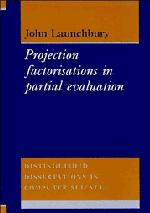Book contents
- Frontmatter
- Abstract
- Contents
- Preface
- 1 Partial Evaluation in Principle
- 2 Partial Evaluation in Practice
- 3 Static Projections
- 4 Binding-Time Analysis
- 5 Run Time Arguments
- 6 Implementation
- 7 Polymorphism
- 8 Conclusion
- A Implementation of PEL
- B Implementation of BTA
- C Implementation of Specialisation
- D Library Functions
- Bibliography
- Index
3 - Static Projections
Published online by Cambridge University Press: 04 August 2010
- Frontmatter
- Abstract
- Contents
- Preface
- 1 Partial Evaluation in Principle
- 2 Partial Evaluation in Practice
- 3 Static Projections
- 4 Binding-Time Analysis
- 5 Run Time Arguments
- 6 Implementation
- 7 Polymorphism
- 8 Conclusion
- A Implementation of PEL
- B Implementation of BTA
- C Implementation of Specialisation
- D Library Functions
- Bibliography
- Index
Summary
The equations for mix assume that it is operating on a two argument function where the first argument is static and the second dynamic. This is the canonical case. In practice we cannot hope that all functions will turn out this way. For example, a function may have many arguments, the first and third being static, say. Alternatively, a single argument may have both static and dynamic parts. We need a framework for reducing the general case to the canonical case.
We can simplify the general case by requiring that all functions have exactly one argument. In first-order languages this is no real restriction. Functions must always be applied to all their arguments, so we can just express them as a single tuple. The next stage is to factorise this single (composite) argument into two parts, the static and the dynamic. We use the results of binding-time analysis to control the factorisation.
Note that, even though functions will only have one argument, we will still loosely describe them as having many. For example, we will talk of a function f (x, y) = … as having two arguments when this is appropriate.
Motivation
For the present we will focus our attention on the static part of the argument. To select the static part, we use a function from the argument domain to some domain of static values. If we make the static domain a sub-domain of the original we can simply “blank out” the dynamic part of the argument and leave the static part unchanged.
- Type
- Chapter
- Information
- Project Factorisations in Partial Evaluation , pp. 28 - 37Publisher: Cambridge University PressPrint publication year: 1991

